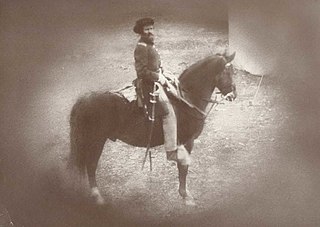
The 5th United States Colored Cavalry was a regiment of the United States Army organized as one of the units of the United States Colored Troops during the American Civil War. The 5th USCC was one of the more notable black fighting units. It was officially organized in Kentucky in October 1864, after its first two battles. It was commanded by Colonel James Brisbin until February 1865, when he took over the 6th US Colored Cavalry. His executive officer, Louis Henry Carpenter, commanded the regiment until 20 March 1866.

Alvan Cullem Gillem was a general in the Union Army during the American Civil War. Although Southern-born, he remained loyal to the Federal government and fought in several battles in the Western Theater before commanding occupation troops in Mississippi and Arkansas during Reconstruction. He later played a prominent role in the Modoc War in 1873.
The 8th Michigan Cavalry Regiment was a cavalry regiment that served in the Union Army during the American Civil War.
The 10th Michigan Cavalry Regiment was a cavalry regiment that served in the Union Army during the American Civil War.

The Battle of Marion was a military engagement fought between units of the Union Army and the Confederate Army during the American Civil War near the town of Marion, Virginia. The battle was part of Union Maj. Gen. George Stoneman's attack upon southwest Virginia, aimed at destroying Confederate industrial infrastructure near Saltville and Marion. Union Cavalry and Infantry regiments—some 4,500 soldiers in total—left Tennessee on December 17 for southwestern Virginia.
The 1st Kentucky Cavalry Regiment was a cavalry regiment that served in the Union Army during the American Civil War.
The 45th Kentucky Mounted Infantry Regiment was a mounted infantry regiment that served in the Union Army during the American Civil War.
Battery "C" 1st Kentucky Light Artillery was an artillery battery that served in the Union Army during the American Civil War. It was often referred to as Neville's Battery.
The 11th Kentucky Cavalry Regiment was a cavalry regiment that served in the Union Army during the American Civil War.
The 12th Kentucky Cavalry Regiment was a cavalry regiment that served in the Union Army during the American Civil War.
Battery E, 1st Battalion Tennessee Light Artillery was an artillery battery that served in the Union Army during the American Civil War. It originally mustered as Battery "D", 1st Tennessee Heavy Artillery, and as late as January 1864, it was referred to in reports as 1st East Tennessee Heavy Artillery.
The 13th Tennessee Cavalry Regiment was a cavalry regiment that served in the Union Army during the American Civil War. The regiment was originally designated 12th Tennessee Volunteer Cavalry, but was changed by order of Governor Andrew Johnson on December 31, 1863.
The 9th Tennessee Cavalry Regiment was a cavalry regiment that served in the Union Army during the American Civil War.
The 8th Tennessee Cavalry Regiment was a cavalry regiment that served in the Union Army during the American Civil War.
The 9th Ohio Cavalry Regiment was a cavalry regiment that served in the Union Army during the American Civil War.
The 12th Ohio Cavalry Regiment was a cavalry regiment that served in the Union Army during the American Civil War.

Stoneman's raid in 1865, also called Stoneman's last raid, was a military campaign in the Upper South during the American Civil War, by Union cavalry troops led by General George Stoneman, in the region of eastern Tennessee, western North Carolina and southwestern Virginia.
The 6th Regiment Indiana Cavalry was a cavalry regiment that served in the Union Army during the American Civil War.

The 112th Illinois Volunteer Infantry was an infantry regiment in the Union Army during the American Civil War. It was organized at Peoria in September 1862 and garrisoned places in Kentucky until Spring 1863. Beginning in April 1863, the regiment served as mounted infantry during the Knoxville campaign, before being dismounted in February 1864. Subsequently, it served in the Atlanta campaign, the Franklin-Nashville campaign, and the Carolinas campaign as part of the XXIII Corps. The regiment was mustered out on June 20, 1865.

The 5th Regiment Indiana Volunteer Cavalry was a cavalry regiment that served in the Union Army during the American Civil War.





